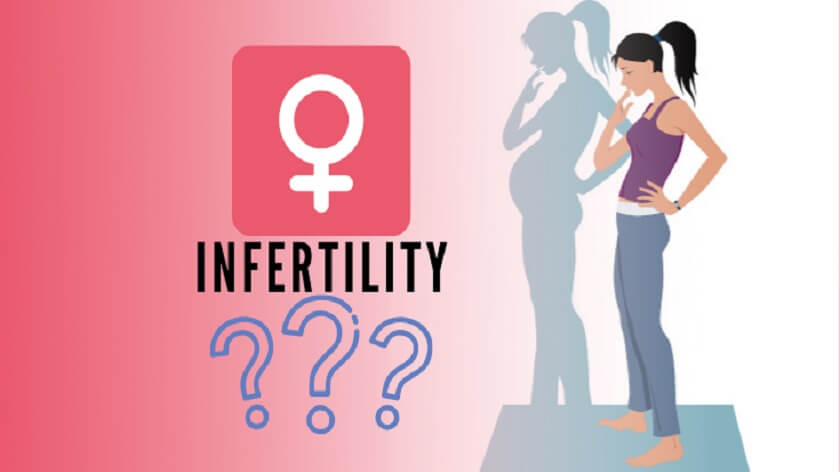If you have tried to conceive for one year but cannot get pregnant, you have female infertility.
Among the causes of infertility in women are endometriosis, uterine fibroids, and thyroid dysfunction.
A low testosterone level or sperm count may be a sign of fertility problems in men.
Fertility problems are more likely to occur as you age.
It’s your doctor’s job to figure out why you’re having trouble getting pregnant, and he/she can work with you to find a treatment that works.
Female Infertility
An infertility disorder affects one’s ability to become pregnant and have a baby.
A heterosexual couple (man and woman) will usually be diagnosed after one year of trying to conceive (but other factors may influence the diagnosis earlier).
Among heterosexual couples, one-third of infertility cases are due to male problems, one-third to female problems, and one-third to a combination of unknown causes.
When the female partner is responsible for infertility, it’s known as female infertility or “female factor” infertility.
Types Of Infertility In Females
Types of infertility include:
- One year after not using birth control, a woman who was never pregnant can’t conceive.
- Infertility that occurs after a successful pregnancy is known as secondary infertility.
Learn about the Causes Of Infertility In Females in the section below.
What Are The Causes For Female Infertility
Infertility can be caused by a variety of factors. It can affect either the female or male reproductive systems.
In order for a woman to become pregnant, her ovaries, fallopian tubes, and uterus must work properly.
Infertility can result from problems with these.
Females who are older (35+ years) and have a history of pelvic infections, endometriosis, autoimmune diseases, and a history of cancer are at higher risk.
Some of the Causes of Female Infertility are:
- Ovulation disorders: The release of an egg from the ovary into the fallopian tube occurs during a menstrual cycle. Anovulatory women are those who do not ovulate.
- A hormonal imbalance called polycystic ovary syndrome (PCOS) causes the egg to either not develop or not release during ovulation.
- A woman with diminished ovarian reserve (DOR) loses the ability to conceive as she ages. In other words, there are fewer and lower-quality eggs available for conception.
- Amenorrhea caused by a failure of the hypothalamus to produce gonadotropin-releasing hormone (GnRH) can cause functional hypothalamic amenorrhea (FHA).
- The ovaries stop producing eggs before the age of 40 due to premature ovarian insufficiency (POI). Usually occurring in women in their 40s or 50s when they haven’t had a period for at least one year, menopause is a natural part of aging.
Female Infertility Symptoms
Most commonly, couples question their fertility when they are unable to get pregnant.
After 12 months of regular, timed intercourse without contraception, women under the age of 35 are considered infertile if they are unable to conceive.
The time period changes to six months for women who are 35 years old or older from 12 months.
Furthermore, infertility in women may not have obvious symptoms, which makes awareness even more crucial.
Furthermore, many of these symptoms may also be associated with other medical conditions.
Whenever you experience any of these symptoms, you should contact your doctor.
- Periods that don’t coincide with each other.
- Periods that don’t exist at all.
- Periods that hurt.
- Inflammation of the uterus.
- Loss of several pregnancies.
Your doctor can perform many tests to diagnose the problem if you have been unable to conceive for six months or a year – depending on your age.
Female Infertility Treatment
Both the woman and her partner need to be tested when investigating suspected infertility.
Women may undergo the following tests:
- Medical history and physical examination
- A blood test to determine whether ovulation hormones are present
- In laparoscopy, an instrument is inserted through a small incision in the abdomen and used to examine the reproductive organs
- with ultrasounds in order to detect fibroids.
It may also be necessary to analyze the male partner’s semen to determine if he is fertile.
When should you seek help for infertility?
After one year of trying, women under 35 who are not pregnant should see a healthcare provider.
If you are older than 35, you should seek help sooner (after six months).
Getting pregnant becomes more difficult as women get older. 30-year-old women are half as fertile as 20-year-old women.
If you have a risk factor that affects fertility, regardless of your gender, you should seek help early.
The Final Word – Female Infertility
There are many challenges associated with infertility. Emotional well-being and relationships can be affected.
Infertility treatments are expensive and can strain finances. The cause of infertility can be determined by your healthcare provider.
Choosing the right treatment for you to successfully expand your family is the first step.
For some couples, getting pregnant is the only option, but others choose adoption.
Your healthcare provider can discuss these options with you.



